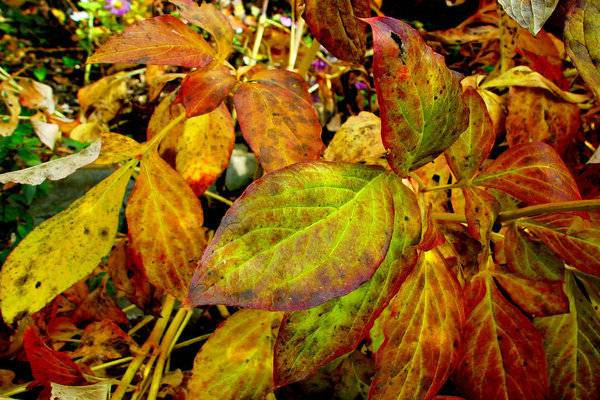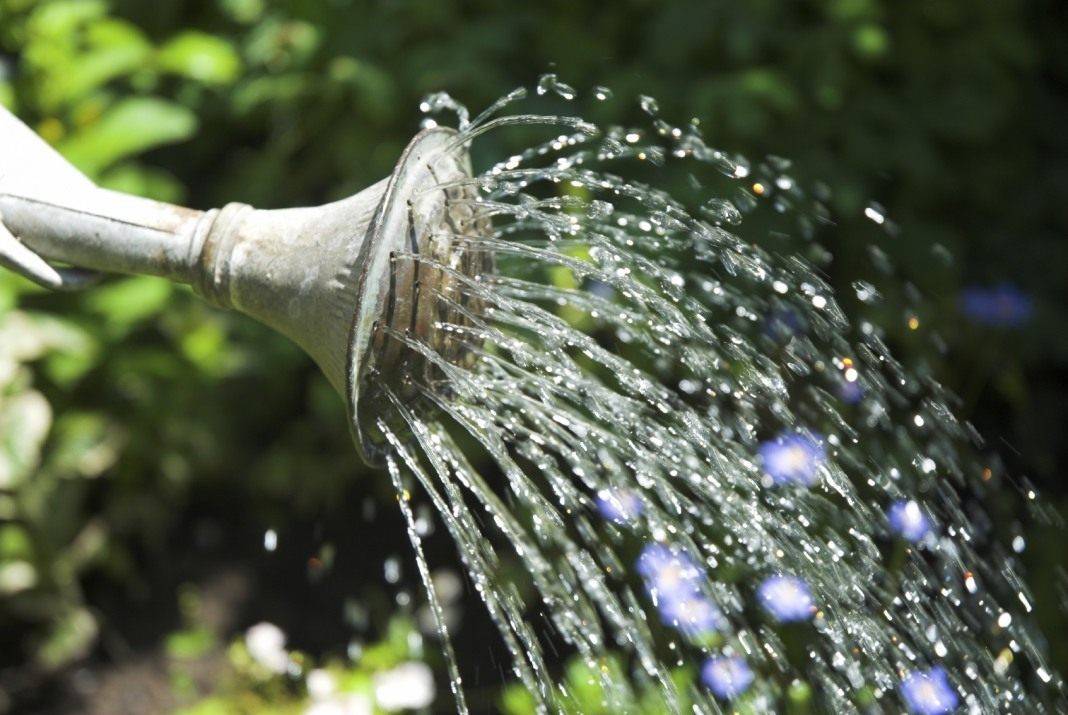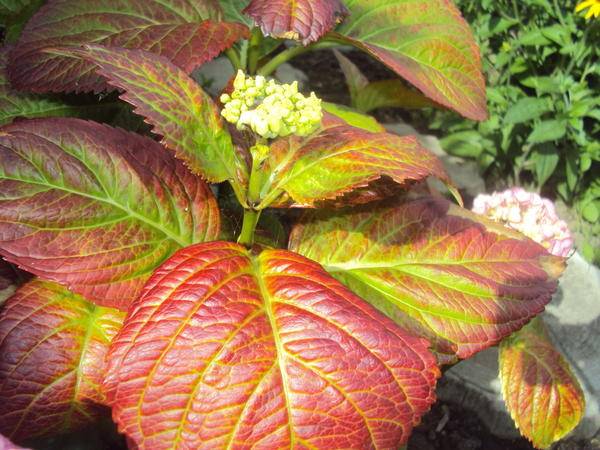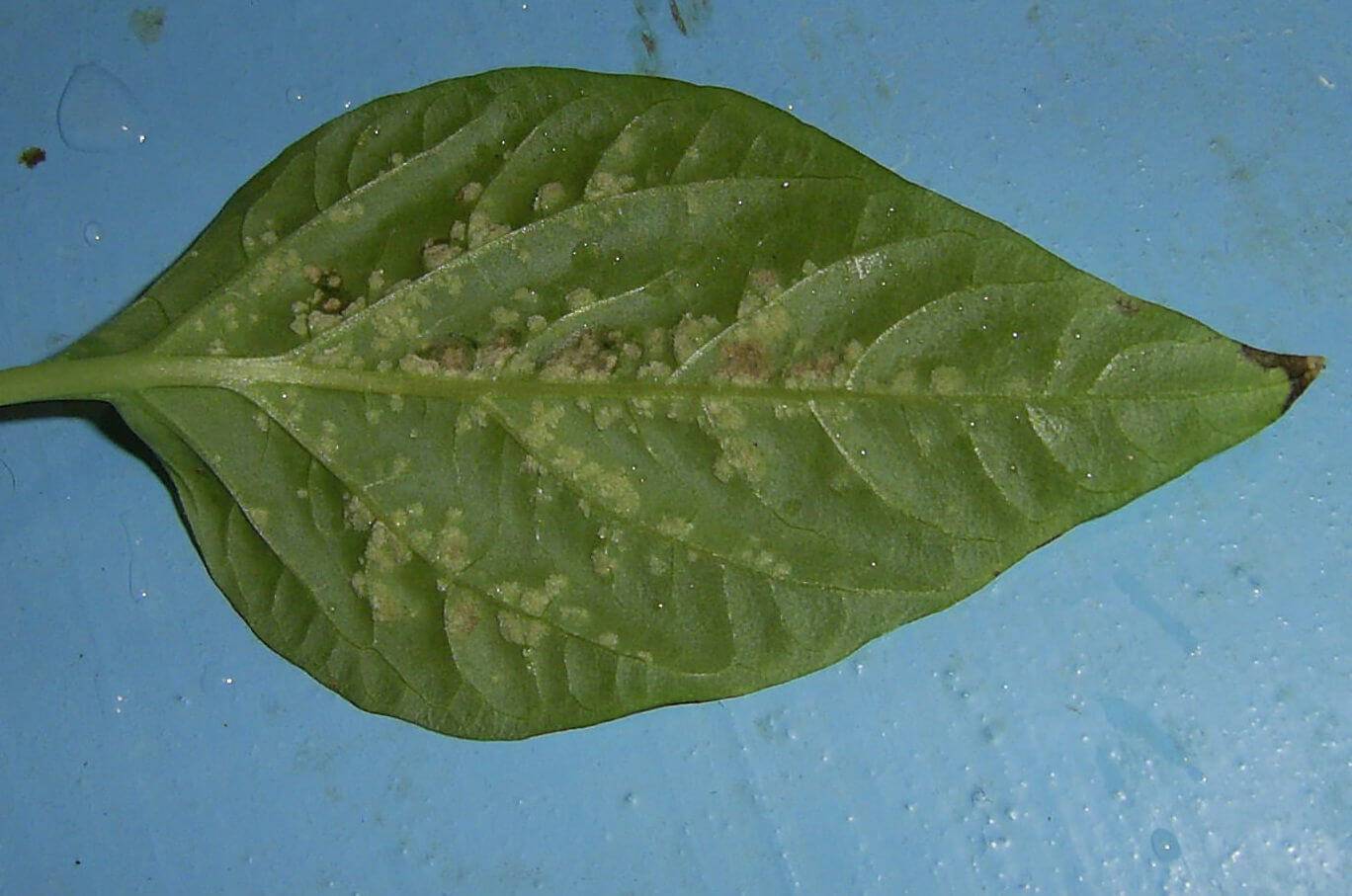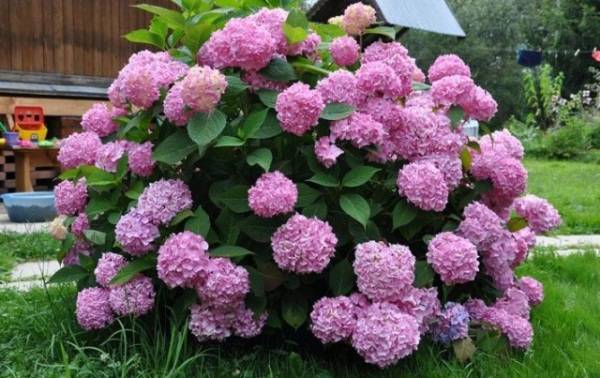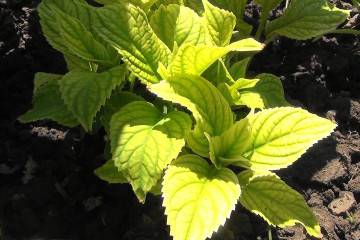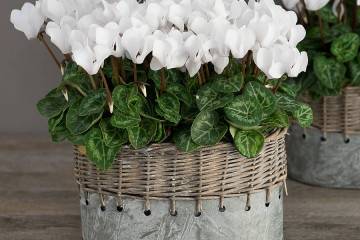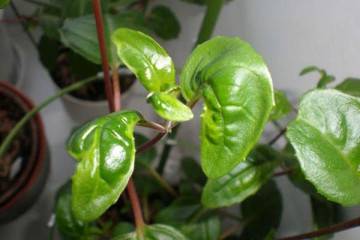Why hydrangea leaves turn red - what to do with the plant
Content:
Novice growers are often interested in why hydrangea leaves turn red. There are quite a few reasons for this phenomenon. The most common provoking factors are attacks of pests, diseases, and disturbances in care. To cope with the problem, you need to take timely action.
Why do hydrangea leaves turn red
Hydrangea is one of the most resistant crops, which practically does not suffer from parasite attacks or the development of diseases. However, sometimes problems do arise.
To understand why the leaves of the hydrangea turned red, it is worth analyzing the situation in detail. In this case, you need to pay attention to the features of care, temperature parameters, illumination, soil composition.
Insufficient acidity of the soil
The reason for the reddening of the foliage in paniculate hydrangea is often insufficient soil acidity parameters. The ideal indicator for this culture is 5 pH. Moreover, many varieties of plants develop normally in slightly acidic or neutral soil.
Damage to the root system
Hydrangea leaves turn red due to root damage. This could be the result of improper transplanting of the plant. This situation requires immediate assistance to the culture. Thanks to this, it will be possible to restore her health.
To stimulate the formation of new roots, the bush must be fertilized 3 times a month. Compliance with the soil moistening regime is of great importance.
Excessive watering
If the edges of the leaf plates of a flower are affected, the reason is most likely in excess moisture. In such a situation, it is necessary to adjust the watering of the crop. Also, the tips of the leaves may turn red due to excess potassium in the soil.
Rooting a seedling in summer
Planting hydrangeas in early summer is not recommended. Under the influence of the active sun, there is a risk of reddening of the leaves of the culture. Planting work should be carried out in the spring. You can also do this in the fall. The best option would be the period before the start of the movement of juices or before the onset of cold weather.
Sunburn
Hydrangea easily withstands the influence of a harsh climate and does not suffer much from high temperatures. However, in the heat, you should be careful. The red leaves of the hydrangea can be caused by direct exposure to the sun.
Watering the soil during the day can also cause problems. This procedure causes burns. If the culture does not withstand exposure to direct sunlight, it needs to be shaded.
Diseases and pests
Chlorosis is considered to be the reason for the change in the color of the leaves. This disease is associated with metabolic disorders. It is associated with a lack of iron and is accompanied by a change in the color of the foliage. If culture is not helped in time, it will lose its decorative properties. To cope with chlorosis, it is worth using iron chelate or Agricol.
Fungal diseases in large-leaved hydrangea are quite rare. However, sometimes it is they that provoke reddening of the foliage. The damaged bush should be treated with copper oxychloride. This substance is a versatile fungicide.
The main types of fungal infections include the following:
- White rot. Initially, the disease affects the roots of the plant, which provokes their rotting. Over time, the culture becomes covered with red spots. Fungicides will help to cope with pathology - in particular, Fitosporin can be used.
- Septoria. With the development of the disease, the foliage becomes covered with brown spots. In this case, the edges of the leaves are darker than the central part. If you do not take action in time, there is a risk of damage to the stems and cuttings. Then the spots combine and the leaves fall off. A damaged crop is unlikely to survive the winter. It is worth treating the plant with copper-containing agents.
- Gray rot. Pathology is accompanied by tissue wateriness. In a drought, they die off and crumble. In a humid environment, fungal spores multiply rapidly. It is quite difficult to cure the disease. Skor, Fundazol will help to do this.
- Rust. If a violation occurs, the leaves are covered with a rusty color. It is due to the large amount of nitrogen in the soil. Spraying will help eliminate the disease. To do this, take 5 liters of water and 20 g of copper.
- Calcium spot. It occurs quite often and is accompanied by the appearance of spots in the form of rings on the foliage. After a while, the leaves are deformed and curled. With a strong defeat, inflorescences suffer. They become small or completely absent. It will not be possible to get rid of the pathology.
Sometimes the redness is caused by parasite attacks. Problems are caused by snails that consume foliage, stems and buds. It will be possible to destroy the parasites mechanically.
Spider mites become the reason for the change in the color of the foliage. In this case, the foliage is covered with yellow spots with a marble pattern. If you do not immediately help the culture, the leaves will dry out and fall off. Soap solution will help to destroy parasites.
Sometimes the plant can be affected by aphids. Most often, parasites infect the lower part of the leaves and lead to the spread of fungi. In difficult situations, when attacking such pests, it is worth using Fitoverm or Akarin.
Another parasite is the root knot nematode. The pest provokes damage to the root system. As a result, swellings appear in this zone and decay processes develop. It can be very difficult to identify pests, since the roots of the plant are most often affected.
What to do if the leaves of a panicle or other hydrangea species turn red
If the foliage turns red, you need to take action right away. First of all, it is necessary to establish the provoking factor of the problems.
If brown spots form on the leaves, a fungal infection is most likely the cause. It needs to be treated with fungicides. For this purpose, Fundazol, Hom, Oxyhom are suitable. The foliage should be processed 2 times on both sides. This is done at intervals of 2 weeks. To strengthen the result, fertilizers are used. The plant requires magnesium sulfate.
The rest of the treatment methods depend on the provoking factor. With an excess of moisture, you need to reduce the amount of watering. Sun protection is also important. It is also worth checking the soil for acidity and adding minerals and organic matter every season.
In winter and summer, it is necessary to mulch the beds. This helps to maintain the optimal temperature regime of the soil and prevent active evaporation of liquid and nutrients.
Feed for hydrangea that has red leaves
When the soil is depleted, it is necessary to apply fertilizers. Wrong acidity leads to impaired absorption of useful elements. To restore the correct parameters, it is worth watering the hydrangea with a citric acid solution. To make it for 10 liters of water, it is worth taking 1 small spoonful of the product. If the roots are damaged, the bush should not be fed.
If the redness of the foliage is due to damage to the root system, crop growth stimulants will help to cope with the problem. They are brought in 3 times a month. Such funds are combined with sufficient watering. It is necessary to apply fertilizers after complete restoration of the roots.
Preventive measures to prevent the appearance of red leaves
To prevent reddening of the foliage, you need to take measures in advance:
- Plant a crop in partial shade. If the hydrangea is grown at home, it is sufficient to remove it from a strongly lit windowsill.
- Avoid dry soil. The culture needs a sufficient amount of moisture and high-quality irrigation. In hot weather, it is worth watering the plant with an interval of 2 days.
- Choose the right substrate. It should have a light structure and high acidity.
- Establish a feeding regime. In late spring, nitrogen is used, and in summer, potassium and phosphorus. In the fall, phosphorus fertilizers are introduced.
- Process the bush in a timely manner. For this purpose, it is recommended to use copper sulfate.
The reddening of hydrangea foliage is due to a variety of factors. Pathologies and pests are common causes of problems. Also, a violation of the rules for caring for the plant leads to damage to the leaves - an incorrect irrigation or fertilization regime. In such a situation, crop care should be adjusted.
